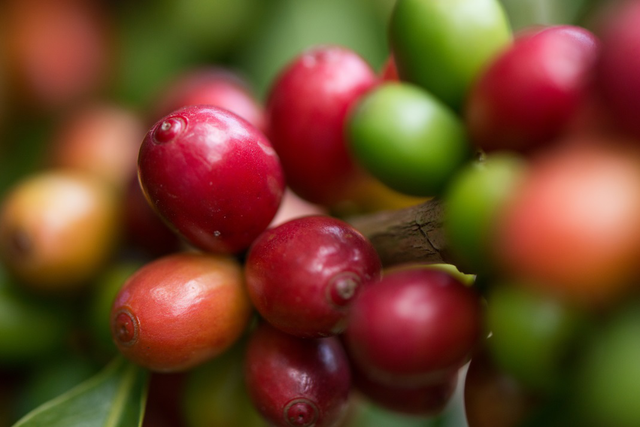A brief introduction to the cultivation of boutique coffee beans in Bolivia
The advantage of Bolivian coffee lies in its high altitude and excellent varieties of coffee, where the traditional Tibica and a small amount of Kaddura are highly valued in the world market. In the past, coffee trees in Bolivia used to act as hedges and ornaments around the garden. Real commercial production began in the early 1950s. The coffee industry in Brazil was badly damaged by the great frost in 1957, while Bolivia (Bolivia) benefited and developed rapidly. Bolivian coffee is grown at an altitude of 18000 to 2670 meters above sea level, and the Arabic washed coffee beans are exported to Germany and Sweden, which is not the best today and has a bitter taste.
Lake Titicaca, located on the Coaya Plateau on the border between Bolivia and Peru, is the highest and largest freshwater lake in South America, one of the highest large freshwater lakes in the world, the highest navigable lake in the world, and the third largest lake in South America (after Lake Maracaibo and Patus lagoon).

Lake Titicaca Copacabana
Country: Bolivia
Altitude: 3812m
Producing area: Lake Titicaca
Baking degree: medium baking
Treatment: washing
Variety: iron pickup
Producer: tapping Baigabana small farmers
Flavor: dried aromas of roasted nuts and almonds, orange and pomelo
Bolivia has the absolute potential to become a premium coffee producer, and now it also produces a small amount of premium coffee. The total national output is slightly smaller than that of a slightly larger single coffee plantation in Brazil. But production is decreasing year by year, and coffee plantations are disappearing with astonishing figures. Perhaps in the near future, it will be increasingly difficult to see quality coffee from Bolivia on the market.
There is very little information on how coffee entered Bolivia and the history of coffee cultivation in the country. It is found from the literature that there was a large amount of coffee production in Bolivia in the 1980s, but the information is limited to this. The country is not small, about the same size as Ethiopia or Colombia. Because it is a landlocked country, it has faced some challenges in export in the past, especially the extra cost of time and cost.
Bolivia has a small population, with only 10.5 million people. Most people are quite poor, and about 25% of the country's population is in extreme poverty. The country depends on minerals and natural gas as well as agriculture, with coffee growing in the minority. The impact of growing coca leaves for drugs on the economy and agriculture is too great to ignore. Many coffee farmers have begun to switch to coca leaves because the price of coca leaves fluctuates less and provides more living security for producers. Between 2010 and 2011, when coffee prices were high, many farmers were encouraged to switch to coffee production with financial assistance from the anti-drug programs of Bolivia and the United States. Since then, however, coffee prices have fallen again, and many farmers have switched to coca leaves.
Bolivia has an ideal environment for growing coffee in many ways: high enough above sea level and a distinct dry and wet climate. Domestic coffee multi-ripe ancient native varieties, such as Tibika and Kaddura. In recent years, some high-quality, pure and complex coffee has been exported from Bolivia, but this is not the norm.
In the past, coffee producers used to remove the pulp of coffee after harvest and then transport it to the central processing plant. This creates two major problems: first, the coffee may freeze when it is transported to the processing plant; second, there is still considerable humidity in the pulp, so it will continue to ferment, so the coffee will be of poor quality and unpleasant smell. Now more and more quality coffee farmers begin to deal with the harvested fruit on their farms. The United States has subsidized the establishment of several small wet coffee treatment plants across Bolivia as part of anti-drug planned economic subsidies. Even though the coffee industry has made many changes to improve its quality, Bolivian coffee still lacks the fame of neighboring Colombia or Brazil.
Coffee competitions such as the Excellence Cup enable the best Bolivian coffee to rise to prominence. I recommend that you look for these coffees and enjoy them while they are still on the market. Even if boutique coffee does have a better rate of return, even coffee farmers who require quality are starting to give up coffee production.
Important Notice :
前街咖啡 FrontStreet Coffee has moved to new addredd:
FrontStreet Coffee Address: 315,Donghua East Road,GuangZhou
Tel:020 38364473
- Prev

Flavor description of Bolivian Coffee production area
The coffee producing area Yungas Yungas, located in the Andean hills just east of La Paz, is a rugged agricultural area. The road to Yangas is rugged and dangerous, making it difficult to transport coffee. But despite the above disadvantages, the coffee in this area is very unique because of its unique microclimate and incredible altitude. The highest altitude in the world
- Next

Discovery of Rosa coffee bean and description of its planting flavor and taste
Rose is full of sweetness and cleanliness on the palate, with rich aromas ranging from berry and citrus to mango, papaya and peach. A very obvious lemon (bergamot) general aftertaste is also a typical cup test attribute. So far, Rose Summer has been the champion of coffee varieties. Daniel is the first coffee to find the unique flavor of rose summer by cup test.
Related
- Detailed explanation of Jadeite planting Land in Panamanian Jadeite Manor introduction to the grading system of Jadeite competitive bidding, Red bid, Green bid and Rose Summer
- Story of Coffee planting in Brenka region of Costa Rica Stonehenge Manor anaerobic heavy honey treatment of flavor mouth
- What's on the barrel of Blue Mountain Coffee beans?
- Can American coffee also pull flowers? How to use hot American style to pull out a good-looking pattern?
- Can you make a cold extract with coffee beans? What is the right proportion for cold-extracted coffee formula?
- Indonesian PWN Gold Mandrine Coffee Origin Features Flavor How to Chong? Mandolin coffee is American.
- A brief introduction to the flavor characteristics of Brazilian yellow bourbon coffee beans
- What is the effect of different water quality on the flavor of cold-extracted coffee? What kind of water is best for brewing coffee?
- Why do you think of Rose Summer whenever you mention Panamanian coffee?
- Introduction to the characteristics of authentic blue mountain coffee bean producing areas? What is the CIB Coffee Authority in Jamaica?

